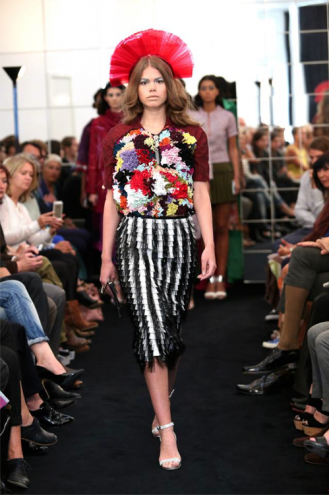Dutch fashion designer Liselore Frowijn takes creative inspiration from the tensions that underlie our rushed, city-bound lives. Her complex, layered ensembles play off the clash between the ease of sportswear and the luxury of formal attire.
“People have an urge for beautiful products and luxury goods, but at the same time we prefer comfort since we do so many different things in a single day,” says the young designer, who was recently nominated as a finalist for the Dutch Design Awards' Young Designer Award. “When you combine those two extremes into one, a clash between sports and luxury arises. I find this clash very interesting to work with.
Frowijn sees the ubiquity of sportswear in our lifestyles as indicative of the speed with which we live. “Globalisation makes it possible to be connected with the entire world – somehow we can be involved in many places,” says the Amsterdam-based fashion designer, who graduated cum laude from ArtEZ Institute of the Arts in Arnhem, the Netherlands, in 2013.
The rhythm of our daily lives changes – speed sets in. Sportswear symbolises this feeling for me.
Her Autumn/Winter 2015 collection, called “Fracture Space”, is a striking meditation on the juxtapositions resulting from modern life’s compromises. The silhouette is based upon biking-jackets and polo-shirts, carried out in tweed and finished with sporty piping. These are combined with hand-painted fabrics and materials from the outdoor industry, together with rich Italian jacquards.
The garments use folds and layers to build up substantial lines and contours. The designs radiate confidence but this strength is offset by materials that are light, flowing and comfortable.
The collection’s title refers to the way the vertical stripes in her hand-painted textiles define space. “I divided space into stripes just like Gerhard Richter does in his ‘Strip Paintings’,” says Frowijn, who regularly draws inspiration from art. “With this as a subject, I started knotting with vertical ties of jersey, painting and spraying, drawing with markers, etc. And an entire new collection of materials came into existence.”
On a trip to her favourite museum, the Boijmans Van Beuningen in Rotterdam, she connected with the work of Austrian expressionist Oscar Kokoschka. She was struck by his portraits, and the way they represent the subject’s energy field. She wanted her “Fracture Space” collection to have the same dynamism and powerful aura.
Frowijn made her debut with her bold and forward-thinking graduate project, "Afternoon of a Replicant". Like her second collection, it is characterised by the layering and clash of sportswear and luxury. The collection was inspired by Matisse's paper cut-outs.
"These enormous collages in bright colours represent his own imaginary world. It was this world I wanted to create for a modern young woman during our era, where speed is an important subject," she explains.
By cutting and pasting with paper, I have created a modern cut out-suit for women of my time, in the same bright colours and shapes as the ones Matisse used, but carried out in fabrics used in sportswear, such as lycra.
The idea is practical luxury, suitable for a youthful, active lifestyle. The title recalls the beautiful cyborg characters in Ridley Scott’s Bladerunner whose fast living was at the cost of their longevity.
Since graduating last year, Frowijn has been very busy. After winning top honours for her graduate collection at the annual Dutch Design Awards in 2013, she immediately began an internship at textile company Mantero Seta SPA in Como, Italy. Then guerrilla-shows in Paris during fashion week, a job with Vlisco developing a collection, and participation in the Hyères International Fashion and Photography Festival where she won the Grand Prix Chloe. She will present her work as part of the DDW Future Series at the IT'S WEEKEND festival this Friday 5 September.
It comes as no surprise that a designer who synthesises so many disparate elements in her work finds her inspiration all around her – “the city (Amsterdam), art, my friends, the music I listen to, subjects I read in the papers”.
“It all piles up together in my head as one big image. Then, I give myself permission to lock myself up in the studio with all kinds of textiles and materials and translate this collage of images I have in my mind,” Frowijn says.

















